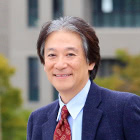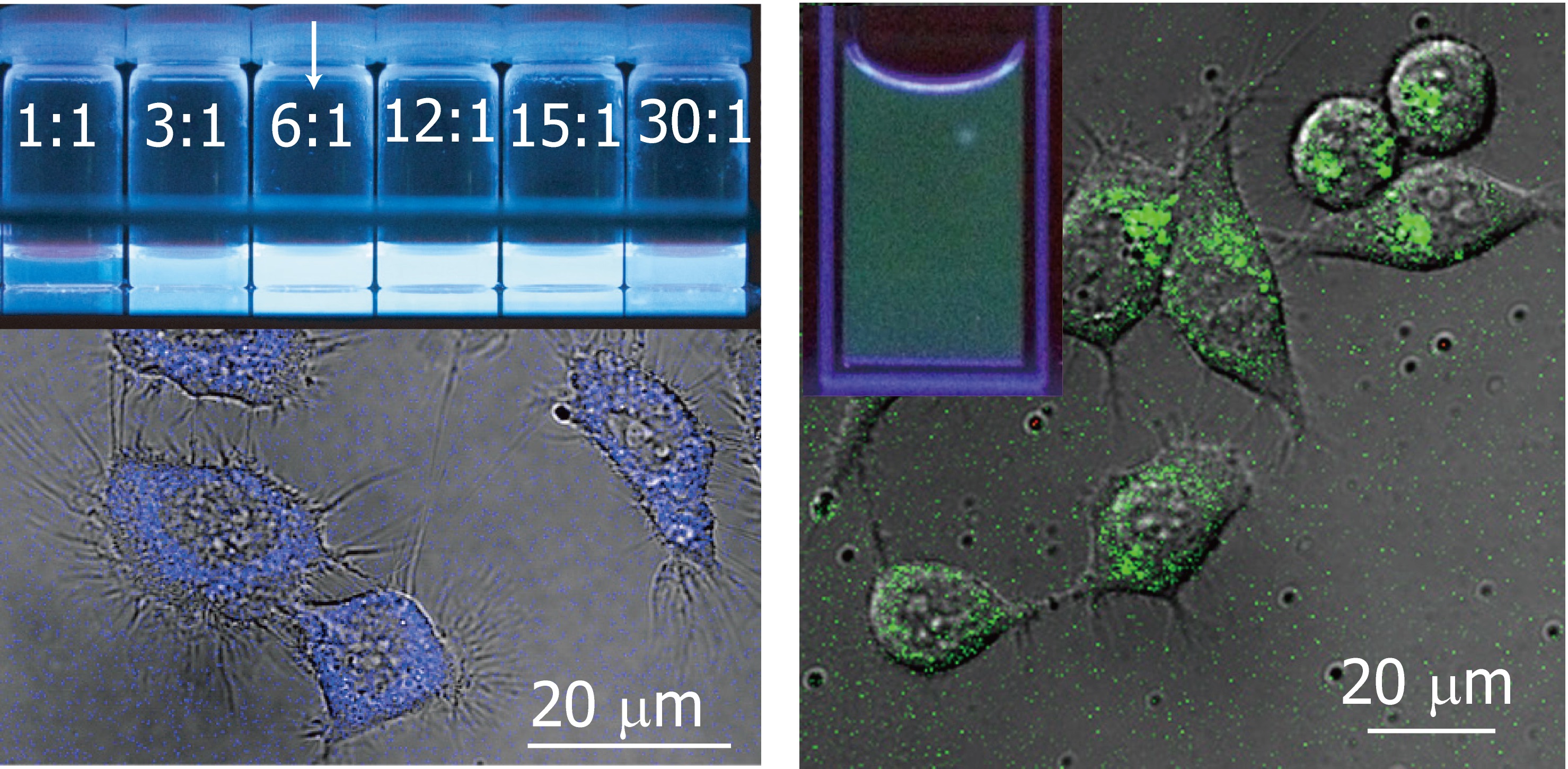Biophysical Dynamics Laboratories
Nano-Biophotonics Group
 Prof. INOUYE Yasushi
Prof. INOUYE Yasushi
Keywords:
Nano-Biophotonics, Plasmon resonance, Raman spectroscopic analysis, Metal nano cluster, Manipulation of photonic molecules
Observing bio molecules by making full use of photonics
We carry out research on nano-biophotnics, a new research field that spans the field of nanotechnology, biology, and photonics. We develop techniques to observe living cells and biomolecules with ultra-high spatial resolution and sensitivity, by utilizing nanotechnology based on nano-materials such as metal nanoparticles/clusters, and vibrational spectroscopy such as rthe Raman analysis of molecules. Our current topics are focused on the development of synthesizing fluorescent metal nano clusters for bio-imaging, the explication of the functions of neural cells by Raman spectroscopy and imaging, the measurement of living cells by Brillouin spectroscopy, the development of ultra-high sensitive plasmon sensors using Fano resonance, optical nano measurement and the development of imaging techniques using an optical-induced nano manipulation of molecules.

Fluorescent image of HeLa cells stained by Pt nano clusters.
Members
| Yasushi Inouye (Professor) | inoue[at]fbs.osaka-u.ac.jp |
|---|---|
| Hidekazu Ishitobi (Associate Professor) | h-ishito[at]fbs.osaka-u.ac.jp |
| Kyoko Masui (Visiting Researcher) | |
| Yurie Takeda (Secretary) |
You could probably reach more information of individual researchers by Research Map and researcher's search of Osaka-U.
- ※Change [at] to @
Q&A
- What is your hot research topic?
- Our main focus is metal nanoclusters composed of several to several tens of metal atoms. These metal nanoclusters have optical characteristics similar to those of semiconductor quantum dots, and exhibit intrinsic absorption and emission characteristics depending on the number of atoms that are formed when electrons are confined in a space of 1 nanometer or less. We are vigorously developing functionalized fluorescent probes by establishing nanocluster synthesis methods, elucidating luminescence mechanisms, and controlling the electronic state of nanoclusters via alloying and chemical modification.
- What is your breakthrough or research progress in the last 5 years?
- We have developed probes for biosensing and imaging, including fluorescent metal nanoclusters composed of platinum atoms and metal nanostructures that resonantly scatter light of a specific wavelength (called the plasmon effect). Until now, only blue fluorescence had been emitted, but by optimizing the synthesis conditions, we succeeded in synthesizing fluorescent platinum nanoclusters that emit green and yellow fluorescence. We have also clarified the formation mechanism of nanoclusters through various analyses. Furthermore, DNA structural changes due to transcription factors have been clarified at the nano-scale using the plasmon effect resulting from the dimeric structure of metal nanoparticles.
- What kind of background do your lab members have?
- We have been conducting research with members specializing in various research fields such as nano-photonics (spectroscopy, optical measurement, photochemistry), nanotechnology, biophysics, synthetic chemistry, biochemistry, and surface science.
- Do you collaborate with other institutions and universities?
- In Japan, research is being promoted in collaboration with the National Institute of Advanced Industrial Science and Technology (AIST), Shizuoka University, the Toyohashi University of Technology, and overseas, with the Optics & Photonics Center at the Moroccan Foundation of Advanced Science, Innovation and Research (MAScIR), and the Australian National University in Australia.
- What kind of careers do your Lab's alumni go on to?
- Manufacturers of precision instruments that handle optical instruments, measuring instruments, electronics, etc., and government agencies.
- How do you develop your research?
- In addition to the development of new probes that realize the sensing and imaging of biomolecules with high sensitivity and high spatial resolution by synthesizing metal nanomaterials such as fluorescent nanoclusters, measuring and evaluating optical properties, and elucidating the luminescence mechanism we would like to elucidate the kinetics of biomolecules at the nano-level by devising measurement methods and microscopic imaging methods that make maximum use of probe characteristics. We are also developing quantitative measurement and imaging methods using near-infrared spectroscopy, which is transparent to the living body, and aiming to establish a new method for monitoring metabolic processes.
Research Highlights
Publications (Research Articles, Reviews, Books)
2022
Potassium Ion Dynamics Imaging through Supported Lipid Bilayers with Surface Plasmon Resonance Microscopy
ACS Photonics 9, 3412-3420 2022 ( DOI:10.1021/acsphotonics.2c01009)
Detection of Glutamate Encapsulated in Liposomes by Optical Trapping Raman Spectroscopy
ACS Omega 7, 9701-9709 2022 ( DOI:10.1021/acsomega.1c07206)
2021
Incident Angle Dependence of Raman Scattering for Distinct Vibrational Modes Enhanced by Surface Plasmon Resonance Excited on a Silver Thin Film
J. Phys. Chem. C 125, 27678-27684 2021 ( DOI:10.1021/acs.jpcc.1c09119)
Optical Characterization of Ultra-Thin Films of Azo-Dye-Doped Polymers Using Ellipsometry and Surface Plasmon Resonance Spectroscop
Photonics 8, 41 2021 ( DOI:10.3390/photonics8020041)
2020
Optical Trapping of Photosoftened Solid Polymers
J. Phys. Chem. C 124, 26037-26042 2020 ( DOI:10.1021/acs.jpcc.0c08068)
Deuterated Glutamate-Mediated Neuronal Activity on Micro-Electrode Arrays
Micromachines 11, 830 2020 ( DOI:10.3390/mi11090830)
Surface Enhanced Visible Absorption of Dye Molecules in the Near-Field of Gold Nanoparticles
Sci Rep 10, 3913 2020 (PMID:32127595 DOI:10.1038/s41598-020-60839-0)
2018
Plasmonic coupled modes in metal-insulator-metal structures for sensing applications
Proceedings of SPIE 10722:107220O 2018 ( DOI:10.1117/12.2319936)
Resolution Enhancement of Plasmonic Sensors by Metal‐Insulator‐Metal Structures
Ann. Phys.-Berlin 530:1700411 2018 ( DOI:10.1002/andp.201700411)
2017
Near-field optical mapping of single gold nano particles using photoinduced polymer movement of azo-polymers
Opt. Commun. 387:24-29 2017 ( DOI:10.1016/j.optcom.2016.11.028)
2016
Plasmonic coupled modes in metal-dielectric multilayer structures: Fano resonance and giant field enhancement
Opt. Express 24(18):20080-20088 2016 (PMID:27607617 DOI:10.1364/OE.24.020080)
Light-tunable Fano resonance in metal-dielectric multilayer structure
Sci Rep 6:33144 2016 (PMID:27623741 DOI:10.1038/srep33144)
Our ideal candidate (as a graduate student)
We are looking for a highly motivated person to work on our research topics as our lab member. Our lab welcomes the person who loves taking care of creatures, hand working and handcraft too. Any kind of background (such as your expertise or major) is available.
Contact
Nano-Biophotonics Group, Graduate School of Frontier Biosciences, Osaka University,
1-3 Yamadaoka, Suita, Osaka 565-0871 Japan.
TEL: +81-6-6879-4600
E-mail: inoue[at]fbs.osaka-u.ac.jp (Prof. Yasushi Inouye)
- ※Change [at] to @
